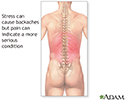Lifting and bending the right way
Nonspecific back pain - lifting; Backache - lifting; Sciatica - lifting; Lumbar pain - lifting; Chronic back pain - lifting; Herniated disk - lifting; Slipped disk - liftingMany people injure their backs when they lift objects the wrong way. When you reach your 30's, you are more likely to hurt your back when you bend to lift something up or put it down.
Injure their backs
Low back pain refers to pain that you feel in your lower back. You may also have back stiffness, decreased movement of the lower back, and difficult...

This may be because you have injured the muscles, ligaments, or disks in your spine in the past. Also, as we get older our muscles and ligaments become less flexible. And, the disks that act as cushions between the bones of our spine become more brittle as we age. All of these things make us more prone to having a back injury.
How you can Prevent Injury
Know how much you can safely lift. Think about how much you have lifted in the past and how easy or hard that was. If an object seems too heavy or awkward, get help with it.
Warm up or stretch before you lift heavy weights. The better conditioned your body and your joints are, the less injury or pain you will have.
If your work requires you to do lifting that may not be safe for your back, talk to your supervisor. Try to determine the most weight you should have to lift. You may need to meet with a physical therapist or occupational therapist to learn how to safely lift this amount of weight.
Know how to lift in the correct way. To help prevent back pain and injury when you bend and lift:
- Spread your feet apart to about shoulder width to give your body a wide base of support.
- Stand as close as possible to the object you are lifting.
- Bend at your knees, not at your waist or back.
- Tighten your stomach muscles as you lift the object up or lower it down.
- Hold the object as close to your body as you can.
- Slowly lift, using your muscles in your hips and knees.
- As you stand up with the object, do not bend forward.
- Do not twist your back while you bend to reach the object, lift the object, or carry the object.
- Squat as you set the object down, using the muscles in your knees and hips. Keep your back straight when you squat down.
References
Hertel J, Onate J, Kaminski TW. Injury prevention. In: Miller MD, Thompson SR, eds. DeLee, Drez, & Miller's Orthopaedic Sports Medicine. 5th ed. Philadelphia, PA: Elsevier; 2020:chap 34.
Lemmon R, Leonard J. Neck and back pain. In: Rakel RE, Rakel DP, eds. Textbook of Family Medicine. 9th ed. Philadelphia, PA: Elsevier Saunders; 2016:chap 31.
-
Backaches - illustration
Although stress can cause backaches it is wise to watch out for other signs that may indicate a more serious condition. Pain which radiates to the buttocks, arms or legs, and weakness or numbness in the arms and legs should not be ignored.
Backaches
illustration
-
Herniated lumbar disk - illustration
Herniated lumbar disk is a condition in which part or all of the soft, gelatinous central portion of an intervertebral disk (the nucleus pulposus) is forced through a weakened part of the disk, resulting in back pain and nerve root irritation.
Herniated lumbar disk
illustration
-
Backaches - illustration
Although stress can cause backaches it is wise to watch out for other signs that may indicate a more serious condition. Pain which radiates to the buttocks, arms or legs, and weakness or numbness in the arms and legs should not be ignored.
Backaches
illustration
-
Herniated lumbar disk - illustration
Herniated lumbar disk is a condition in which part or all of the soft, gelatinous central portion of an intervertebral disk (the nucleus pulposus) is forced through a weakened part of the disk, resulting in back pain and nerve root irritation.
Herniated lumbar disk
illustration
-
Back pain and sciatica - InDepth
(In-Depth)
-
Low back pain
(Alt. Medicine)
-
Urinary incontinence - InDepth
(In-Depth)
-
Scoliosis - InDepth
(In-Depth)
-
Gastroesophageal reflux disease and heartburn - InDepth
(In-Depth)
-
Osteoarthritis - InDepth
(In-Depth)
Review Date: 8/12/2023
Reviewed By: C. Benjamin Ma, MD, Professor, Chief, Sports Medicine and Shoulder Service, UCSF Department of Orthopaedic Surgery, San Francisco, CA. Also reviewed by David C. Dugdale, MD, Medical Director, Brenda Conaway, Editorial Director, and the A.D.A.M. Editorial team.




